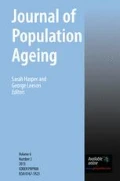Abstract
An explicit goal of age-friendly community initiatives is that neighborhoods should include residents of all ages. This quality has been little assessed, either in naturally-occurring communities or in communities engaged in age-friendly interventions. We addressed the research questions: How commonly does the age distribution of a neighborhood reflect the age distribution of the U.S. as a whole? What types of representative and non-representative neighborhoods exist, and what are their sociodemographic characteristics? We conducted a descriptive analysis of data from the 2010 Census on the age distribution of the 71,864 populated census tracts that comprise the lower 48 United States. We found that approximately two-thirds of neighborhoods had age distributions that differed from the age composition of the U.S. Neighborhoods that overrepresented older adults aged 60 and older were almost one-quarter of all neighborhoods. Age representative and age non-representative neighborhoods differed in their racial/ethnic and socioeconomic composition as well. We conclude that most individuals lack neighborhood exposure to an age representative cross-section of the U.S. population. We discuss the implications of this finding for policymaking in age-friendly community initiatives.


References
Moorman, S. M., Stokes, J. E., & Morelock, J. C. (2016). Mechanisms linking neighborhood age composition to health. The Gerontologist.
Cagney, K. A. (2006). Neighborhood age structure and its implications for health. Journal of Urban Health, 83(5), 827–834.
Chevan, A. (1982). Age, housing choice, and neighborhood age structure. American Journal of Sociology, 87(5), 1133–1149.
Feld, S. L., & Carter, W. C. (1998). When desegregation reduces interracial contact: a class size paradox for weak ties. American Journal of Sociology, 103(5), 1165–1186.
Gonyea, J. G., & Hudson, R. B. (2015). Emerging models of age-friendly communities: a framework for understanding inclusion. Public Policy & Aging Report, 25(1), 9–14.
Greenfield, E. A., Oberlink, M., Scharlach, A. E., Neal, M. B., & Stafford, P. B. (2015). Age-friendly community initiatives: conceptual issues and key questions. The Gerontologist, 55(2), 191–198.
Howden, L. M., and Meyer, J. A. (2011). Age and sex composition: 2010. U.S. Department of Commerce, Economics and Statistics Administration, U.S. Census Bureau. http://www.census.gov/prod/cen2010/briefs/c2010br-03.pdf
Jacobsen, L.A., Mather, M., & DuPuis, G. (2012). Household change in the United States. Population Bulletin, 67(1). http://www.prb.org/pdf12/us-household-change-2012.pdf
Lee, B. A., Reardon, S. F., Firebaugh, G., Farrell, C. R., Matthews, S. A., & O'Sullivan, D. (2008). Beyond the census tract: patterns and determinants of racial segregation at multiple geographic scales. American Sociological Review, 73(5), 766–791.
Massey, D. S., & Denton, N. A. (1988). The dimensions of residential segregation. Social Forces, 67(2), 281–315.
Reardon, S. F., Matthews, S. A., O’Sullivan, D., Lee, B. A., Firebaugh, G., Farrell, C. R., & Bischoff, K. (2008). The geographic scale of metropolitan racial segregation. Demography, 45(3), 489–514.
U.S. Census Bureau. (2011). 2010 census summary file 1. Data file. www.census.gov/prod/cen2010/doc/sf1.pdf
U.S. Census Bureau. (2013). Glossary: Census Tract. www.census.gov/dmd/www/glossary.html
Winkler, R. (2013). Segregated by age: are we becoming more divided? Population Research and Policy Review, 32(5), 717–727.
Winkler, R., & Klaas, R. (2012). Residential segregation by age in the United States. Journal of Maps, 8(4), 374–378.
World Health Organization. (2007). Global age-Friendly cities: A Guide. http://www.who.int/ageing/publications/Global_age_friendly_cities_Guide_English.pdf
Author information
Authors and Affiliations
Corresponding author
Rights and permissions
About this article
Cite this article
Moorman, S.M., Stokes, J.E. & Robbins, S.C. The Age Composition of U.S. Neighborhoods. Population Ageing 9, 375–383 (2016). https://doi.org/10.1007/s12062-016-9140-8
Received:
Accepted:
Published:
Issue Date:
DOI: https://doi.org/10.1007/s12062-016-9140-8

